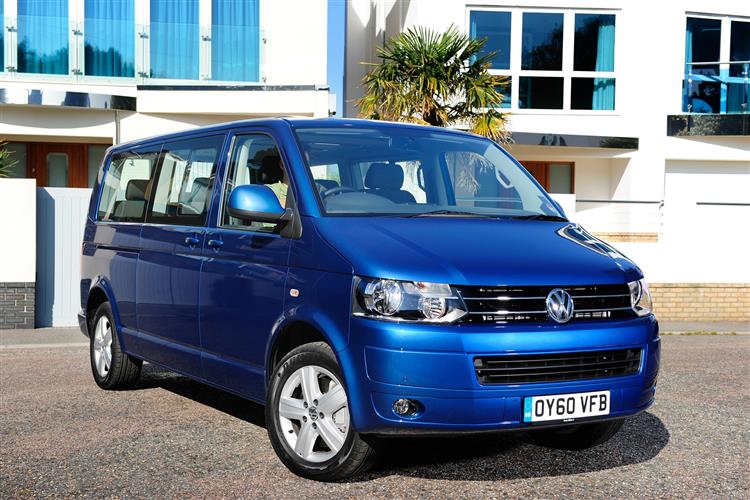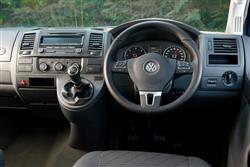This is a sample, showing 30 seconds of each section.
CONQUEST OF SPACE (some text hidden) SECTIONED_new_volkswagencaravelle_2013
By Jonathan Crouch
Introductionword count: 72
Serious about space? So is Volkswagen's Caravelle. In contrast to the largest conventional MPVs on the market, it'll not only take seven people but all their luggage too, thanks to commercial origins refined by decades of development that have created a quality car-like feel for driver and passengers alike. Ultimately, there isn't much that can do what a Caravelle can. Here, we look at the T5 generation version as a used buy.
Modelsword count: 12
(5dr MPV 2.0 TDI 140PS, 2.0 TDI 180PS diesel [SE, Executive, Business])
Historyword count: 352
The Volkswagen Caravelle. It is, in every way, the definitive extra-large people carrier, developed over half a century of history that has seen this vehicle and its predecessors share and change the lives of countless families in almost every country of the world. Such a simple concept you'd think - a windowed van for people rather than packages - but then the best ideas always are. This one came from a Dutch vehicle importer called Ben Pon who just after WWII, spotted workers at Volkswagen's Wolfsburg factory using a stripped-down Beetle to move parts around. Inspired, he sketched out a platform for a versatile commercial vehicle that would brilliant for business and, with seats and windows, fine for families too. Following the 1950 launch, it was the seated versions that most captured the public's imagination, early versions of which were known by a whole variety of names - the Samba bus, the Kombi, the Microbus or even, in the swinging Sixties, the 'hippie bus'. In America, it was simpler: a people carrying Transporter was just known as a 'Volkswagen Bus'. These vehicles offered simple, utilitarian people transport but by the time the third generation T3 Transporter model was introduced in 1980, Volkswagen thought it had identified an extra market amongst buyers who liked the size and versatility but wanted to move their passengers around in more car-like surroundings. So was born the Caravelle. The T5 version we look at here was based on the fifth generation T5 Transporter van series first introduced back in 2003 and was of course a far cry from the crude but characterful original buses. Fully car-like qualities though, only arrived with the 2010 introduction of the facelifted version we'd suggest you try and focus on, a model which belatedly dispensed with noisy, inefficient direct injection diesel engines in favour of quieter modern common rail power. The result, in this guise, can be almost anything you want - a huge family runabout, an up-market taxi or even a fully-fledged business limousine. This T5 generation Caravelle range sold until mid-2015 when it was replaced by the T6 generation model.
What You Getword count: 1113
There's something a little more up-market about a Caravelle, a class and quality that marks it out from mainstream brand rivals. You can't imagine a Chairman of the Board being prepared to cruise about in a rival Ford Tourneo Custom or Hyundai i800, however much leather and burr walnut it had inside it. But this Volkswagen can - and does - mix it in limousine circles, sliding seamlessly in amongst the finest four-doors of the corporately wealthy. From the era we're looking at here, only Mercedes' Viano could match it in this respect - and that's a smaller but pricier proposition. Even low-spec Caravelles look smartly self-assured, van-derived origins partly disguised by the clear horizontal lines and chrome trim of frontal styling designed to replicate that used across Volkswagen's passenger car line-up. The headlights and grille merge within a single bar running across the front end, with the grille section split by chrome slats. There's another chrome separator in the air intake carved into the bumper and the whole thing's set off by beady-eyed cornering foglamps and an aerodynamic set of wing mirrors. There's nothing remotely fashionable on offer here but it's all quietly classy in its own restrained way. But of course, what matters is what you'll find inside. It would of course have been quite possible in something this big - the short wheelbase version is nearly 5m long and nearly 2m wide - to shoehorn in eight or nine seats as rival models from Ford and Hyundai do. As indeed Volkswagen also does in the 'Transporter Shuttle' and 'Transporter Window Van' minibus versions of this design. But then that would have created a 'minibus' feel, which is precisely what most Caravelle owners don't want. In fact, some don't even want seven seats. Power open the sliding side door on the top 'Business' version and you'll find a strict six-seater, with three pairs of single chairs that really let their occupants stretch out. Assuming that you're not a CEO though, you'll probably prefer to opt for a much more affordable and more practical 'SE' or 'Executive'-spec Caravelle. Though it was theoretically possible for original owners to specify these variants with the six-chair arrangement, almost all buyers chose the more conventional rear seating layout. That means a three-person rear bench right at the very back and two single chairs in the middle that will usually be turned to face it so that passengers can talk directly to each other rather than to the back of peoples' heads. The front seats can optionally be turned to face those at the rear too and base models have a natty multi-function table that clips in and out of the floor and sits between second and third rows. Customers of the top Business model get a more sophisticated set-up, with a walnut-trimmed refrigerated centre console at the very back and a versatile table top in the middle that can, if required, be turned by 90-degrees, folded and lowered into its base. Whether the plan is for an impromptu business meeting on the M1 or it's just about keeping the kids quiet on the way to your weekend holiday cottage, these are features that really do make a huge difference to the way this car can be used, versatility further aided by four useful floor-mounted rails. These enable the various rear seats to slide into just about any position you want, depending on the vehicle application you have in mind and the amount of people carrying or packaging space you're likely to need. You'll have a bit more flexibility when it comes to doing that if, in looking at the two lower spec versions, you find a Caravelle in the long wheelbase guise that wasn't available to buyers of the top 'Business' edition. This longer bodystyle adds another 400mm to the length and offers owners a bit more scope when it comes to re-positioning the seats about - not in itself an especially easy job such is their individual weight and bulk. We'd certainly want to be in the long wheelbase bodystyle if we were planning to spend the night in our Caravelle. Yes, you can do that too. The rearmost bench is easily converted into a large, almost completely flat bed by pulling a lever and pushing the recliner back and down. Original buyers could specify an optional 'sleep pack' offered a rear seat bed extension and window blinds. And luggage space? Well this is where a super-large People Carrier like this comes into its own. With a conventional car-like large MPV, if all seven seats are occupied, it's unlikely that you'll also have enough space for everyone's luggage. With a Caravelle, it's different. Once you've negotiated the lifting of the huge rear tailgate (something you'll need to have left plenty of space behind the vehicle in order to be able to raise), the cargo capacity with all the seats in use is about double that amount that you'd get in a similar scenario with a large MPV, say like Volkswagen's own Sharan. It's a bit difficult to quote specific cargo capacity figures because they'll vary endlessly of course depending on the seating permutations you've chosen and how far both the rearmost rows are pushed forward. What we can tell you is that with all second and third row seating taken out, it's absolutely enormous inside, with either 5,800 or 6,700-litres of total load capacity, depending on your choice between short or long wheelbase bodystyles. That may be just a touch less than you'd get in a comparable rival Ford Tourneo Custom, but it's significantly more than even the biggest 'Extra-Long' version of the rival Mercedes Viano can offer. And at the wheel? Well, you certainly sit high up - to the point where there's a feeling of sitting on top of the car rather than in it. But it's certainly a commanding perch with excellent all-round visibility - though not to the point where we'd want to be without front and rear parking sensors (unfortunately they were optional from new). Volkswagen's design team did what they could to tone down the dashboard's commercial vehicle origins with leather steering wheel trim, smartly white backlit dials and a colour touchscreen sat nav set-up for top models. Overall though, it is what it is: no soft-touch plastics or chrome-trimmed frippery here and much of the switchgear is sourced from older generation Golfs. Still, some of the van-derived stuff is quite welcome: the dash-mounted gearlever for example or the twin cupholders that fold out from the fascia. And it's certainly very practical with features like properly-sized door pockets that take large drinks bottles. All seems built to last too.
To see the full road test text contact us on 0330 0020 227
Pictures (high res disabled)

.jpg)
|
.jpg)
|
.jpg)
| |||
.jpg)
|
.jpg)
|
.jpg)
| |||
.jpg)
|
.jpg)
|
.jpg)
| |||
.jpg)
|

|
Scoring (subset of scores)
Category: MPV People Carriers
| Performance | |
| Handling | |
| Comfort | |
| Space | |
| Styling, Build, Value, Equipment, Depreciation, Handling, Insurance and Total scores are available with our full data feed. | |



